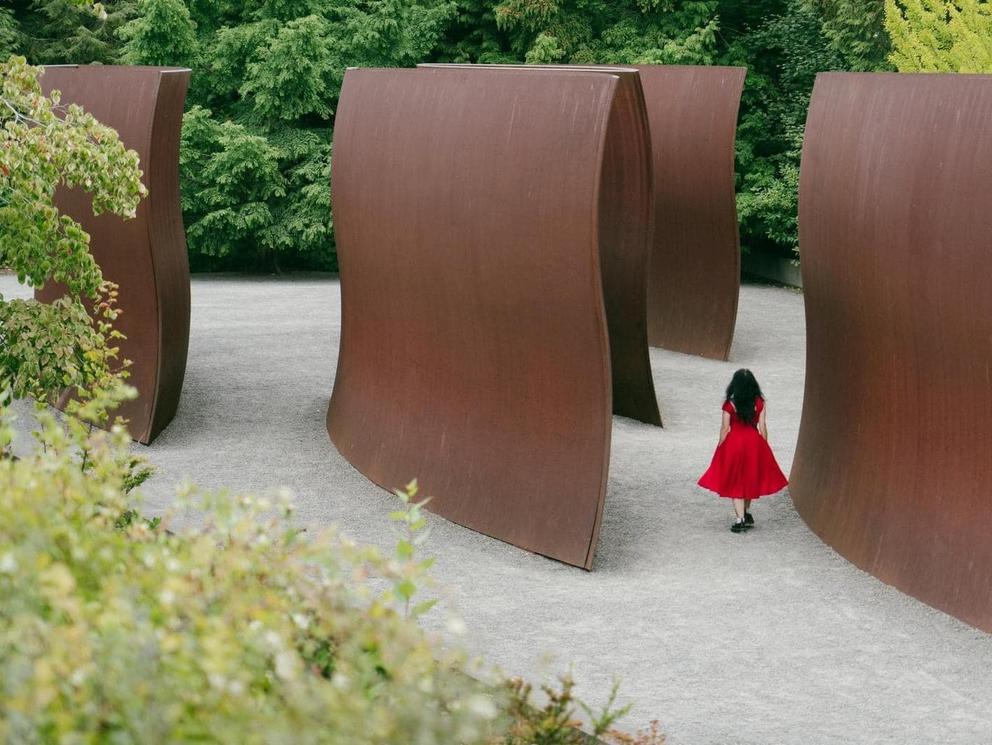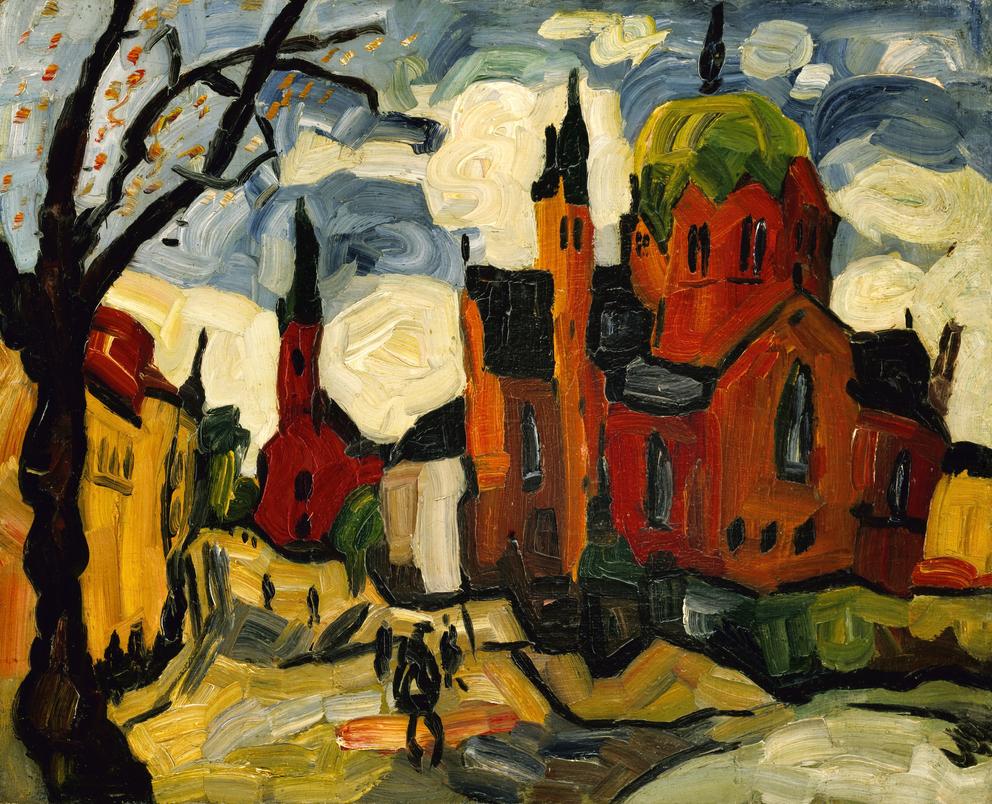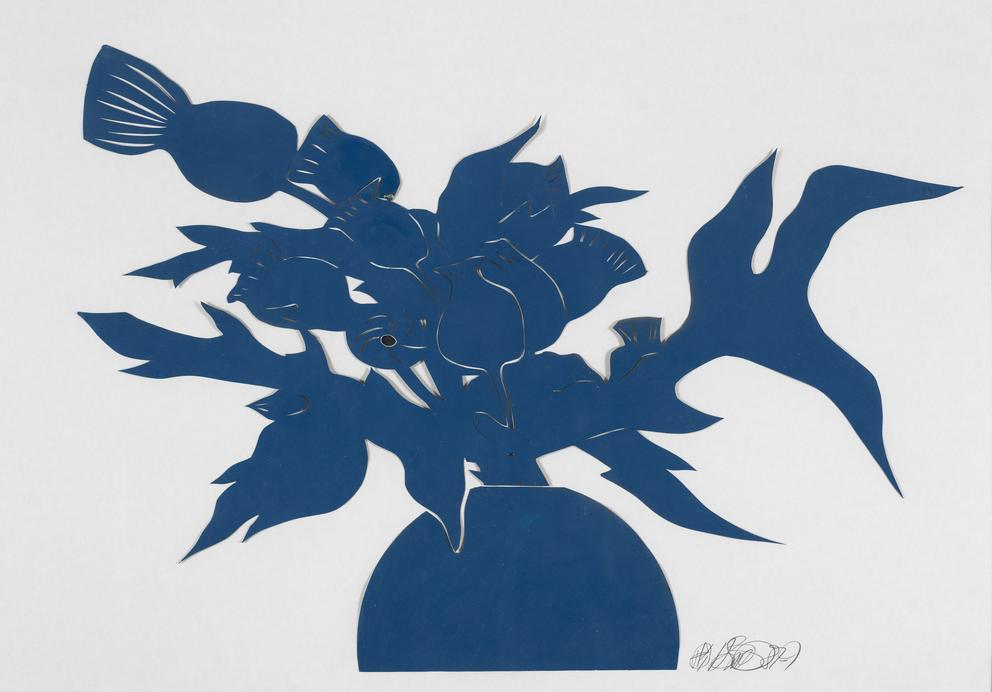“Wake” (2003) sits in a valley at the Seattle Art Museum’s Olympic Sculpture Park. To reach it, visitors descend either a graveled ramp or the wide terraced stairs abutting the PACCAR Pavilion.
I’ve visited countless times since its 2006 installation (including getting married next to it). But when I paid an honorary visit on Tuesday evening I was newly struck by how the walk down to the work gives the sense that you’re traversing a sort of gangplank, approaching an implied sea.
Narrowed at the base of what might be the prow and stern, the five rusted steel forms seem to move as a flotilla, impossibly balanced as a giant ship on water — how does it stay afloat?
Walking among the 14-foot-tall forms imparts the sensation of being in a kayak, paddling next to the looming hulls of anchored ships. It feels both exciting and a little disquieting to be so close. (On this day it brought to my mind images of the giant cargo ship that slammed into the Key Bridge in Baltimore earlier this week.)
“What’s important is you moving between them, through them, and around them as they undulate,” Serra said of the piece. “It’s your body moving in relation to their surface that moves.”
The obituary in The New York Times noted that one of Serra’s most lasting childhood memories was watching the launch of a tanker at the San Francisco shipyard where his father worked during World War II. He said the memory became “a recurring dream.” As a teen, Serra worked in steel mills, giving him knowledge of and appreciation for the industrial material used in ship hulls.
You can experience one of his earlier steel works in Bellingham, at the Western Washington University Sculpture Collection. Among the stunning array of abstract works scattered outdoors across the campus (Isamu Noguchi! Nancy Holt! Donald Judd!) is Serra’s “Wright’s Triangle” (1979-80).
Less undulating than angular, this giant steel triangle seems even more precariously balanced than “Wake,” with three long panels leaned up against each other like a house of cards. Three triangular openings invite the viewer inside to inhabit the geometry, which slices and dices your view of the sky and surroundings. At times it feels like you’re inside a tent, at others a fortress.
As with “Wake,” “Wright’s Triangle” becomes its most artful and affecting when the visitor engages with it. That’s what Serra sought to create: pieces that enable a shift in human perspective with each new view along the path, alongside the interchange of shadow and light.
A new exhibit at the National Nordic Museum reveals another instance of humans experiencing new creative environments. Specifically: the many Black American artists who moved to Nordic countries in search of more freedoms than they were allowed under Jim Crow segregation.
Nordic Utopia? African Americans in the 20th Century (through July 21) is a fascinating look at Black “expatriate” art, with the included works reflecting the creative freedom discovered in Copenhagen, Stockholm, Oslo and Helsinki.
Organized by the National Nordic Museum, the impressive collection of paintings, photographs, film, music and dance was co-curated by NNM chief curator Leslie Anne Anderson alongside Ethelene Whitmire, an African American Studies professor at the University of Wisconsin-Madison.
During an advance walk-through, Whitmire told me that while on a sabbatical in Copenhagen several years ago, she happened to see the tombstone of American jazz saxophonist Ben Webster in the Assistens Kirkegård (she also clued me in that Kirkegaard means “cemetery” in English).
It turns out that several Black jazz musicians are buried there. That’s largely a result of the thriving international scene drawn to the Jazz House Montmartre in Copenhagen in the 1960s and 1970s. Saxophonist Dexter Gordon, for example, lived between Paris and Copenhagen — and his album A Day in Copenhagen will be playing in the galleries on a loop.
Whitmire’s research expanded into a 2019 talk at NNM, which in turn expanded into this exhibit.
In the introduction to the catalog, Whitmire notes the widely recognized prevalence of Black American artists in Paris during this period. But the artists featured in Nordic Utopia?, she says, “sought refuge … in what was perhaps the most unlikely of places — Scandinavia — a region whose population was (and is) overwhelmingly white.”
And while some artists did experience racist encounters and traditions on an individual basis (the question mark in the exhibit title is pointed), it wasn’t the constant threat felt in America. “They were able to focus on writing, compositions, or steady gigs without always dealing with race,” Whitmire told me. “That gave them the freedom to focus on art.”
In addition to the jazz musicians featured, look for Finland-inflected flowers by Howard Smith (whose son, Anderson shared, is a teacher in West Seattle); surrealist Danish dreamscapes by Ronald Burns; expressionistic views of Oslo by William H. Johnson; and sunflowers commingling with cotton fields by Brooklyn-born Danish citizen Walter H. Williams.
And stay tuned for a new Swedish-jazz-inspired dance performance at NNM, choreographed by Seattle’s Donald Byrd.
Get the latest in local arts and culture
This weekly newsletter brings arts news and cultural events straight to your inbox.






